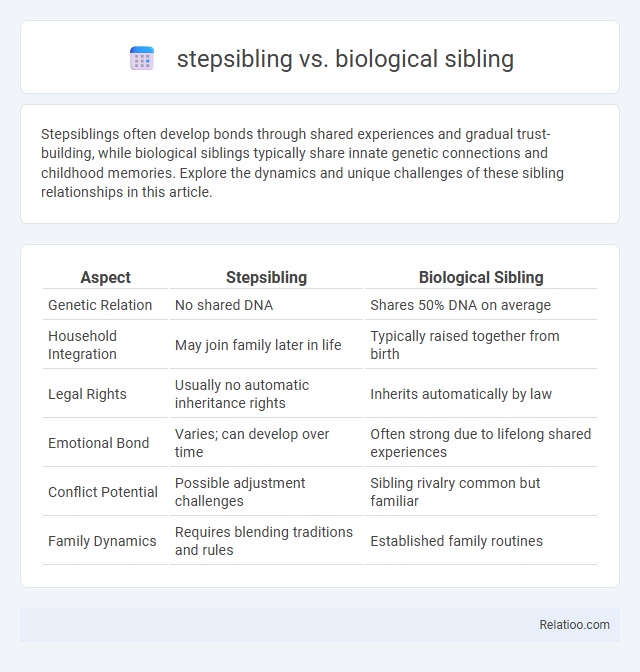Stepsiblings often develop bonds through shared experiences and gradual trust-building, while biological siblings typically share innate genetic connections and childhood memories. Explore the dynamics and unique challenges of these sibling relationships in this article.
Table of Comparison
| Aspect | Stepsibling | Biological Sibling |
|---|---|---|
| Genetic Relation | No shared DNA | Shares 50% DNA on average |
| Household Integration | May join family later in life | Typically raised together from birth |
| Legal Rights | Usually no automatic inheritance rights | Inherits automatically by law |
| Emotional Bond | Varies; can develop over time | Often strong due to lifelong shared experiences |
| Conflict Potential | Possible adjustment challenges | Sibling rivalry common but familiar |
| Family Dynamics | Requires blending traditions and rules | Established family routines |
Understanding Stepsiblings and Biological Siblings
Stepsiblings, unlike biological siblings, do not share genetic ties but become family through the marriage or partnership of their parents. Biological siblings share approximately 50% of their DNA and often have a lifelong genetic and emotional bond, contributing to shared traits, health considerations, and family history. Understanding your relationship with stepsiblings involves recognizing the unique dynamics created by blended families, where emotional connections develop separate from biological ancestry.
Key Differences Between Stepsibling and Biological Sibling Relationships
Stepsibling relationships often lack shared genetic ties and the lifelong biological bond present in biological siblings, resulting in differing emotional dynamics and family roles. Biological siblings usually share a common ancestry and early childhood environment, fostering deep-rooted connections, while stepsiblings may develop bonds later through blended family experiences. Legal and inheritance rights typically favor biological siblings, whereas stepsibling relationships depend more on family integration and personal interactions.
Emotional Bonds: Stepsibling vs Biological Sibling
Emotional bonds between stepsiblings often develop more gradually compared to the innate connection shared by biological siblings, as stepsiblings must navigate new family dynamics and build trust over time. Your relationship with a biological sibling typically benefits from shared genetics and childhood experiences, fostering a deep-rooted sense of loyalty and understanding. While stepsibling bonds can become equally strong, they generally require deliberate effort, communication, and emotional investment to create lasting closeness.
Family Dynamics and Integration Challenges
Stepsiblings often face unique family dynamics and integration challenges due to the lack of shared genetics, which can affect emotional bonding and acceptance within blended families. Biological siblings typically share a deeper, innate connection rooted in genetics, leading to more seamless integration and mutual understanding. You may find that building strong relationships with stepsiblings requires deliberate effort, open communication, and developing trust over time to foster a cohesive family environment.
Legal and Inheritance Considerations
Legal and inheritance considerations differ significantly between stepsiblings and biological siblings. Biological siblings often have automatic rights to inherit under intestate succession laws, whereas stepsiblings usually have no legal inheritance rights unless specified in a will or legal agreement. To protect your interests, it's essential to establish clear legal documentation such as wills or trusts when involving stepsiblings in inheritance matters.
Impact of Parental Roles on Sibling Relationships
Parental roles significantly influence the dynamics between stepsiblings and biological siblings, shaping emotional bonds and conflict resolution patterns. Biological siblings often benefit from consistent parental involvement and shared upbringing, which fosters stronger attachment and mutual support. Stepsiblings may experience varying degrees of parental attention and disciplinary consistency, affecting their relationship quality and requiring deliberate efforts from parents to create an inclusive family environment.
Coping With Rivalry and Conflict
Coping with rivalry and conflict between stepsiblings and biological siblings involves recognizing the unique emotional dynamics present in blended families. Stepsiblings often face challenges related to adjusting to new family roles and forging bonds, requiring open communication and empathy to ease tensions. Biological siblings may experience rivalry rooted in longstanding familiarity, which can be mitigated through consistent boundaries, shared activities, and parental support to foster healthy relationships.
Navigating Loyalty and Identity Issues
Navigating loyalty and identity issues between stepsiblings and biological siblings often involves complex emotional dynamics rooted in family bonds and individual identity formation. Biological siblings typically share genetic ties and a shared upbringing, which can create a natural sense of loyalty and identity connection, whereas stepsiblings must build trust and understanding through shared experiences rather than genetics. Balancing these relationships requires open communication and empathy to foster inclusive family identities that respect both biological connections and the evolving bonds of blended families.
Potential Benefits of Blended Sibling Relationships
Blended sibling relationships often foster unique social skills as You navigate diverse family dynamics, promoting empathy and adaptability beyond those typically found in biological sibling bonds. The potential benefits include enriched emotional support networks and expanded perspectives due to varying life experiences between stepsiblings and biological siblings. These relationships can enhance conflict resolution and communication skills, contributing to stronger familial ties and personal growth.
Supporting Healthy Relationships Among All Siblings
Fostering supportive and healthy relationships among stepsiblings and biological siblings requires emphasizing shared experiences, open communication, and mutual respect. You can encourage bonding through family activities that build trust and understanding, acknowledging the unique challenges stepsiblings might face in blending diverse family dynamics. Prioritizing empathy and consistent positive interactions improves sibling cohesion and emotional well-being for all involved.

Infographic: stepsibling vs biological sibling
 relatioo.com
relatioo.com